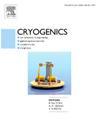Effect of cryogenic treatment at different temperatures on microstructure, thermal, mechanical and corrosion response of pure zinc
IF 1.8
3区 工程技术
Q3 PHYSICS, APPLIED
引用次数: 0
Abstract
The potential for cryogenic treatment (CT) to enhance properties and performance of metals was first realized with steels, followed more recently with non-ferrous examples such as aluminium and magnesium. A wealth of knowledge on the optimum processing parameters and mechanisms behind the property enhancements has been discovered, and this presents a notable research gap for zinc (Zn) as it has never been explored with CT in the past.
To this end, pure Zn was successfully synthesized using the Disintegrated Melt Deposition (DMD) method, followed by hot extrusion and, for the first time, CT with exposure to varying temperatures (−20 °C, −50 °C, −80 °C, and −196 °C). Densification occurred for all materials (with 39.5 % porosity reduction after exposure to −50 °C being most significant), alongside a further 86.5 % increase in damping capacity after exposure to the same temperature. Microstructurally, CT induced significant grain growth across all exposure temperatures, − 80 °C conferring the largest grains (224 % increase over as-extruded equivalent). Compression response was also improved slightly after exposure to −80 °C, with improvements of 2.7 %, 2.3 %, and 1.0 % to compressive yield strength, ultimate compressive strength, and work of fracture. Exposure to −196 °C also notably lowered corrosion rates (32.4 % reduction). This highlights the ability of CT to not just alter, but tailor individual properties for Zn-based materials and opens up a new research area for this Hexagonal Closed Pack (HCP) metal and its derivatives.
不同低温处理对纯锌组织、热、力学和腐蚀响应的影响
低温处理(CT)提高金属性能和性能的潜力首先在钢中实现,最近在铝和镁等有色金属中也得到了应用。关于最佳工艺参数和性能增强背后的机制的丰富知识已经被发现,这对锌(Zn)提出了一个显着的研究空白,因为它在过去从未被CT探索过。为此,采用崩解熔融沉积(DMD)方法成功合成了纯Zn,然后进行热挤压,并首次在不同温度(- 20°C, - 50°C, - 80°C和- 196°C)下进行CT处理。所有材料都发生了致密化(暴露于- 50°C后孔隙率降低39.5%最为显著),同时暴露于相同温度后阻尼能力进一步增加86.5%。显微结构上,CT在所有暴露温度下都诱导了显著的晶粒生长,- 80°C时晶粒最大(比挤压时增加224%)。暴露于- 80°C后,压缩响应也略有改善,抗压屈服强度、极限抗压强度和断裂功分别提高了2.7%、2.3%和1.0%。暴露于- 196°C也显著降低了腐蚀速率(降低32.4%)。这突出了CT不仅可以改变锌基材料的特性,还可以定制其特性,并为这种六边形闭包(HCP)金属及其衍生物开辟了一个新的研究领域。
本文章由计算机程序翻译,如有差异,请以英文原文为准。
求助全文
约1分钟内获得全文
求助全文
来源期刊

Cryogenics
物理-热力学
CiteScore
3.80
自引率
9.50%
发文量
0
审稿时长
2.1 months
期刊介绍:
Cryogenics is the world''s leading journal focusing on all aspects of cryoengineering and cryogenics. Papers published in Cryogenics cover a wide variety of subjects in low temperature engineering and research. Among the areas covered are:
- Applications of superconductivity: magnets, electronics, devices
- Superconductors and their properties
- Properties of materials: metals, alloys, composites, polymers, insulations
- New applications of cryogenic technology to processes, devices, machinery
- Refrigeration and liquefaction technology
- Thermodynamics
- Fluid properties and fluid mechanics
- Heat transfer
- Thermometry and measurement science
- Cryogenics in medicine
- Cryoelectronics
 求助内容:
求助内容: 应助结果提醒方式:
应助结果提醒方式:


